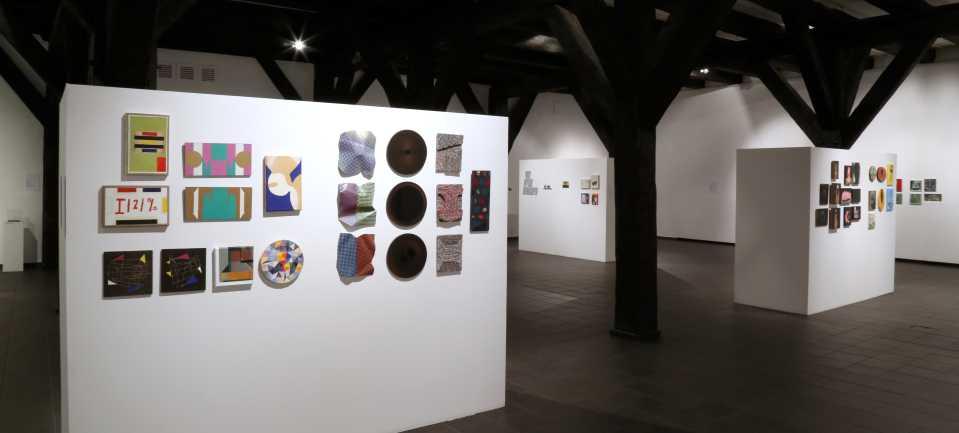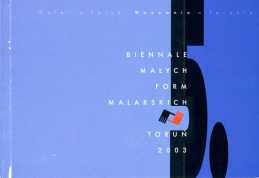
6 minute read
Triennale Małych Form Malarskich The Small-Format Painting Triennial
Triennale Małych Form Malarskich jest ogólnopolską imprezą cykliczną organizowaną w Wozowni od 1988 roku. Początkowo realizowana była w formule biennale, od roku 2010 roku odbywa się w cyklu trzyletnim. Idea wystawy zrodziła się w toruńskim BWA. W regulaminie pierwszej edycji pisano: „Celem BMFM jest prezentacja i konfrontacja poszukiwań i osiągnięć w dziedzinie kameralnej twórczości malarskiej we wszystkich kierunkach twórczych. Pragnieniem organizatorów jest wzbudzenie zainteresowania artystów małą formą wypowiedzi malarskiej i jej szeroka popularyzacja". Kuratorką dwóch pierwszych edycji była Anna Jackowska, która pełniła tę funkcję razem z Jerzym Malinowskim (1988) i Anną Stepnowską (1990). Od 3. BMFM do 10. TMFM pieczę kuratorską nad imprezą sprawowała Teresa Dudzińska, która przeprowadziła Małe Formy Malarskie przez szereg zmian regulaminowych, zachowując jednocześnie wyjątkowy charakter imprezy. The Small-Format Painting Triennial is a nationwide event that has been regularly organised by the Wozownia Art Gallery since 1988. Initially, it was a biennial, but beginning with its 2010 edition it has been held every three years. The idea to organise the first such exhibition emerged in Toruń's BWA. The rules and regulations of the first edition included the following statement: "The aim of the SmallFormat Painting Triennial is to showcase and set side by side the results of artistic explorations and accomplishments in the field of small-format painting, taking into account their all manifestations. The organisers' intention is to stimulate interest in small-format forms of painting among artists and the public." The curator of the first two editions was Anna Jackowska, who was aided in this endeavour by Jerzy Malinowski (1988) and Anna Stepnowska (1990). Beginning with the third edition of the triennial and up until the tenth, the event was curated by Teresa Dudzińska, who introduced into the rules of the Triennial a number of statutory changes, all the while maintaining its unique character.
Advertisement
2. BMFM, wręczenie nagród laureatom / , 19902nd Small-Format Painting Biennial, award ceremony
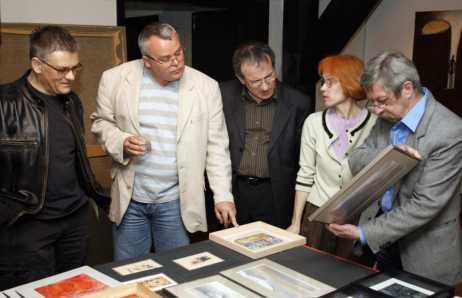
Jury 7. TMFM / The jury of 7th Small-Format Painting Triennial: Jacek Wojciechowski, Janusz Akerman, Piotr Klugowski, Teresa Dudzińska, Marek Hoffman
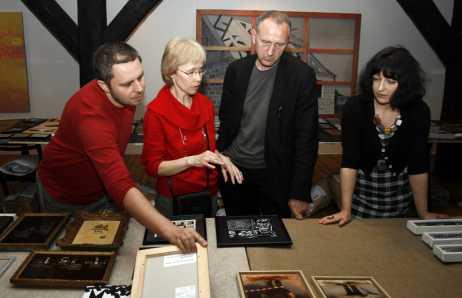
Jury 8. TMFM / The jury of 8th Small-Format Painting Triennial: Łukasz Kiepuszewski, Teresa Dudzińska, Andrzej Zwierzchowski, Beata Ewa Białecka
W regulaminie 8. TMFM umieściła swego rodzaju credo, zachęcające artystów do wychodzenia poza kanon:
„Ograniczenie formatowe nie ma być jedynie alternatywą wielkoformatowych prac, lecz szansą na dzieło skondensowane, treściwe, poszukujące nowych rozwiązań malarskich, adekwatnych do naszych czasów. Akceptując wszelkie propozycje w ramach regulaminu, spodziewamy się prac niekonwencjonalnych, z pomysłem, wywołujących żywą reakcję, stawiających na antypodach naszych oczekiwań banał i komercję. Mały format, dający miejsce refleksji i metaforze, to także pole eksperymentu, gdzie powinno się rodzić coś odmiennego i ryzykownego”.
Ostatnią, 11. edycję TMFM, która odbyła się w 2019 roku, prowadziła Joanna Gwiazda.
Od początku organizatorzy postawili na otwartą formułę konkursu,
pozostawiając artystom pełną swobodę w wyborze techniki,
tematu i stylistyki, rygorystycznie przestrzegając jedynie,
regulaminowego formatu, który wynosił 300 cm 2 . Wraz z kolejnymi
edycjami dopuszczalna wielkość prac ulegała zmianie: od 2. BMFM In the regulations of the eighth edition of the Triennial in 2010 she published a manifesto of sorts, encouraging artists to venture beyond the established canons:
”The format limit is not meant to set these works in opposition to large-format works but to provide an opportunity to create works of art that are condensed, imbued with meaning, and that seek innovative solutions that fit our times. Accepting all proposals that conform to the rules and regulations, we expect to receive works that go against conventions, present original ideas, evoke lively reactions and radically veer our expectations away from banality and commercialism. Small-format painting, a form of expression that gives much room for reflection and metaphor, is also an opportunity to experiment that is likely to give rise to something truly different and daring”.
The most recent, eleventh edition of the triennial took place in 2019 and was curated by Joanna Gwiazda. From the very beginning, the organisers have opted to keep the framework of the competition widely open, which gives artists complete freedom to choose their techniques, subjects and styles.
formę malarską pomyślano jako skierowany do artystów tzw. profesjonalnych – według regulaminu chodziło o absolwentów wyższych uczelni artystycznych lub posiadaczy legitymacji członka ZPAP. Z czasem również te zapisy uległy poszerzeniu i tak od 8. edycji do udziału w konkursie dopuszczono dyplomantów, a od 11. – studentów wyższych uczelni artystycznych. Początkowo organizatorzy zastrzegali sobie prawo do imiennego zaproszenia do udziału w wystawie wskazanych przez siebie artystów, których prace nie podlegały ocenie jury konkursowego. Z czasem jednak od tej praktyki odstąpiono. Jury, składające się z uznanych historyków i krytyków sztuki, kuratorów i artystów, stanowi rękojmię wyboru propozycji najbardziej oryginalnych i reprezentatywnych dla współczesnej kameralnej twórczości malarskiej. Decyduje także o tym, komu przypadną konkursowe nagrody. W czasie trzech pierwszych edycji jury przyznawało Nagrodę Główną i Nagrodę Specjalną za zestaw prac oraz wyróżnienia honorowe. Od czwartej edycji przyznawane są trzy nagrody i wyróżnienia regulaminowe. Fundatorami nagród od lat są Marszałek Województwa Kujawsko-Pomorskiego (Nagroda I) The only strict requirement was that their works could not exceed
the statutory format, with the maximum surface limit set at 300
cm 2 . In later editions, the maximum permissible size was increased
to 400 cm 2 from the 2nd BMFM, and 600 cm 2 from the 8th edition.
The small-format painting competition was conceived as directed
at professional artists – the rules and regulations limited the pool of participants to graduates of art universities and ZPAP members. With time, this limitation was also lifted: from the 8th edition, prospective graduates of art universities in their final year of study were allowed to participate, and from the 11th edition this was extended to include students. Initially, the organisers reserved the right to personally invite groups of artists whose works were not to be assessed by the competition jury. With time, however, this practice was abandoned.
The jury, consisting of renowned art historians and critics, curators and artists, guaranteed that the selection of artworks would meet stringent criteria of originality, also making sure that they would present a representative sample of contemporary small-format painting. The jury also awards the competition prizes. During the
8. TMFM / 8th Small-Format Painting Triennial, 2010
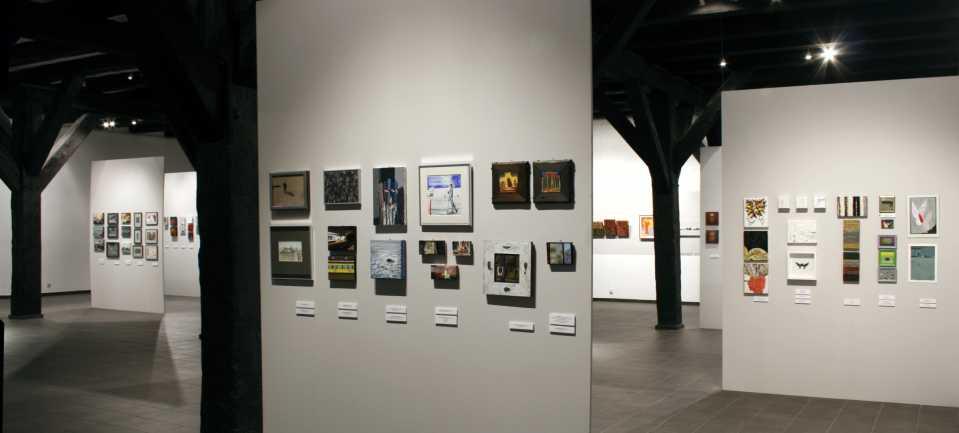
i Prezydent Miasta Torunia (Nagroda II). Przy niektórych edycjach lista nagród była poszerzana o nagrody fundowane przez instytucje lub prywatnych sponsorów. W 2019 roku organizatorzy ustanowili nową nagrodę – w związku z dopuszczeniem do konkursu studentów przyznawana jest Nagroda Specjalna dla najlepszej pracy studenckiej TMFM, fundowana wspólnie przez Rektora UMK i Galerię Sztuki Wozownia (organizacja wystawy indywidualnej). Do tradycji należy towarzyszący wystawie pokonkursowej plebiscyt publiczności na najciekawszą pracę Triennale. (JG)
Logo Triennale Małych Form Malarskich Logo of the Small-Format Painting Triennial projekt / : Wiesław Szamockidesign first three editions, the jury awarded the Main Prize and the Special Prize for sets of works as well as honourable mentions. Since the fourth edition, three prizes and statutory distinctions have been awarded. For years, the prizes have been funded by the Marshal of the Kujawsko-Pomorskie Voivodeship (Prize I) and the Mayor of Toruń (Prize II). In some editions, the awards included prizes funded by other institutions and private sponsors. In 2019, the organisers established a new prize: in view of the admission of students to the competition, the Special Prize for the best student work of the Triennial is awarded, funded jointly by the Rector of the Nicolaus Copernicus University and the Wozownia Art Gallery, which consists of organising an individual exhibition of the winner's work. The prize-winners' exhibitions are traditionally organised after the competition, and a poll among visitors is conducted to choose the most interesting work of the Triennial. (JG)
11. TMFM / 11th Small-Format Painting Triennial, 2019
